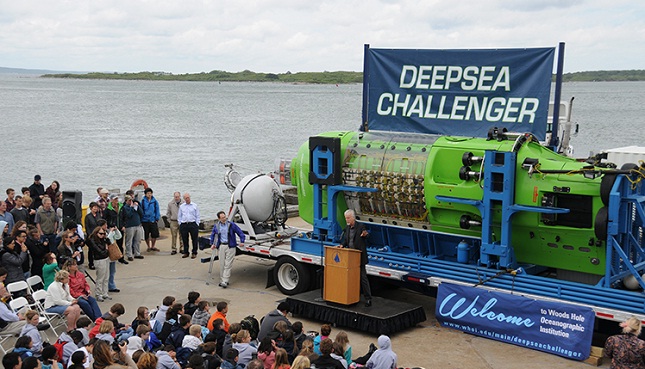WHOI Welcomes Explorer and Director James Cameron and the DEEPSEA CHALLENGER

Photo: Woods Hole Oceanographic Institution president and director Susan Avery receives the DEEPSEA CHALLENGER submersible and a "Remove Before Flight" pin from filmmaker James Cameron. (Photos by Ken Kostel, Woods Hole Oceanographic Institution)
On Friday, June 14, filmmaker James Cameron delivered the DEEPSEA CHALLENGER, the only human-occupied vehicle currently able to access the deepest parts of the ocean, to Woods Hole Oceanographic Institution. Dr. Susan Avery, president and director of Woods Hole Oceanographic Institution, along with the scientific research community, welcomed Cameron and the submersible to its new home at Woods Hole Oceanographic Institution.
“WHOI is a world leader in deep submergence, both piloted and robotic. I’ve been informally associated with WHOI for more than 20 years, and I welcome this opportunity to formalize the relationship with the transfer of the DEEPSEA CHALLENGER submersible system and science platform. WHOI is a place where the DEEPSEA CHALLENGER system will be a living, breathing, and dynamic program going forward,” said Cameron.
It took Cameron’s team of engineers seven years to design and build the DEEPSEA CHALLENGER for his solo dive to the deepest place on Earth—the Challenger Deep in the Mariana Trench. On his solo dive to 35,787 feet, almost 11,000 meters, he captured high-resolution 3D images and collected samples that have already resulted in identification of at least 68 new species plus evidence of the deepest bacterial mats ever discovered.
WHOI envisions a range of uses for the DEEPSEA CHALLENGER system that will bring value to research programs in ocean trenches. For example, WHOI scientists are currently using the DEEPSEA CHALLENGER’s cameras and lighting systems in the Caribbean’s Cayman Trench on the Hybrid Remotely Operated Vehicle Nereus, which dove to the Mariana Trench in 2009 and will return to trenches in the Pacific in 2014.
Woods Hole was the final stop of a cross-country journey transporting DEEPSEA CHALLENGER to its new home. Supported by Rolex, the trip aimed to engage and inspire children by making the sub available to students and the general public, so they could see it, touch it, and ask questions. The journey began with the first public display of the sub at the California Science Center in Los Angeles on June 1; from there it traveled to the Perot Museum in Dallas, and the Georgia Aquarium in Atlanta.
“One of the most critical aspects of exploration, besides actually going there and bringing back the pictures and the science, is the telling of the story. It’s vital to communicate to the public, especially students of all ages, what was done, how it was done, and why it was important,” said Cameron. “By telling the story to school-kids in a hands-on way, we can inspire the next generation of engineers, scientists and explorers, who are so vital to the nation. This will create a major inspirational dividend of the DEEPSEA CHALLENGE project.”
 The sub’s penultimate stop was June 11 in Washington, D.C., where students and families turned out to see the sub up close and hear from its engineers about its technological advances and capabilities. Dr. Avery and Jim Cameron provided a Congressional staff briefing and then testified at a hearing of the Senate Committee on Commerce, Science, and Transportation on “Innovative Partnerships in Ocean Observation” in Washington, D.C.
The sub’s penultimate stop was June 11 in Washington, D.C., where students and families turned out to see the sub up close and hear from its engineers about its technological advances and capabilities. Dr. Avery and Jim Cameron provided a Congressional staff briefing and then testified at a hearing of the Senate Committee on Commerce, Science, and Transportation on “Innovative Partnerships in Ocean Observation” in Washington, D.C.
“We brought the message to Washington that the ocean is a resource that should be valued and protected,” said Avery.
A public event featuring the DEEPSEA CHALLENGER will be organized for later this summer.
The Woods Hole Oceanographic Institution is a private, non-profit organization on Cape Cod, Mass., dedicated to marine research, engineering, and higher education. WHOI builds and operates the deep-sea exploration vehicles of the National Deep Submergence Facility (NDSF) for the benefit of the entire US oceanographic community. The NDSF includes the human occupied vehicle Alvin, the remotely operated vehicle Jason, and the autonomous vehicle Sentry. Established in 1930 on a recommendation from the National Academy of Sciences, its primary mission is to understand the oceans and their interaction with the Earth as a whole, and to communicate a basic understanding of the oceans’ role in the changing global environment. For more information, please visit www.whoi.edu.
